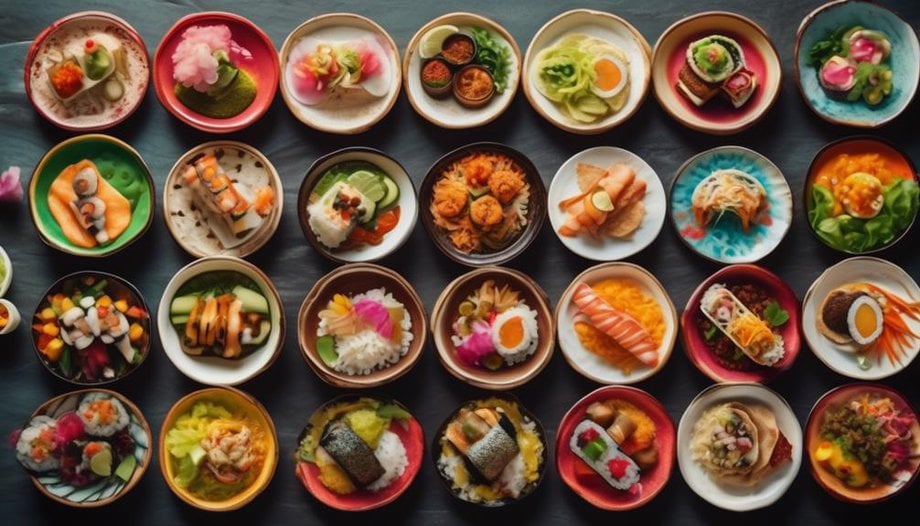How to Introduce Kids to Global Cuisines for Nutritional Diversity

Introducing kids to global cuisines is a great way to expand their palates and promote nutritional diversity. Here are some tips to help you get started:
- Start with familiar flavors: Begin by incorporating flavors and ingredients that your child is already familiar with. For example, if they enjoy tacos, try introducing them to Mexican cuisine.
- Explore new cuisines: Research different global cuisines and select a few that you think your child might enjoy. Consider cuisines like Italian, Indian, Thai, or Greek, which offer a wide variety of flavorful and nutritious dishes.
- Get them involved: Involve your child in the cooking process. Take them grocery shopping and let them choose some ingredients for the new dishes. Encourage them to help with simple tasks like washing vegetables or stirring sauces.
- Make it fun: Turn mealtime into an adventure by learning about the culture behind the cuisine you are trying. Share interesting facts about the country, its traditions, and its food customs.
- Start with small portions: When introducing new dishes, start with smaller portions to avoid overwhelming your child. Allow them to taste and explore new flavors at their own pace.
- Experiment with spices: Don't be afraid to experiment with different spices and seasonings. Spices can add depth and flavor to the dishes and make them more appealing to kids.
- Be a role model: Set a good example by trying new foods yourself. Kids are more likely to be open to trying new things if they see their parents enjoying them.
- Be patient: It may take several attempts before your child develops a taste for new cuisines. Don't give up, and continue to offer a variety of foods to expand their palate.
Remember, introducing kids to global cuisines is not only a great way to promote nutritional diversity but also an opportunity to teach them about different cultures and foster a sense of curiosity and adventure when it comes to food.
Exploring New Flavors and Ingredients
To expand your child's culinary horizons, encourage them to explore new flavors and ingredients through creative food art and the use of customary utensils from different cultures. Introducing your child to diverse food cultures not only broadens their palate but also helps them gain a deeper understanding and appreciation for different cultures around the world.
One way to explore new flavors and ingredients is through food art. Encourage your child to create colorful and visually appealing dishes using a variety of ingredients. They can arrange fruits and vegetables into fun shapes or even create edible sculptures. This not only makes mealtime more enjoyable but also allows them to experiment with different flavors and textures.
Another way to introduce new flavors and ingredients is by using customary utensils from different cultures. For example, you can let your child try eating sushi with chopsticks or using a tortilla to wrap their food like in Mexican cuisine. By incorporating these utensils into mealtime, your child can experience the cultural significance of certain foods and develop a sense of curiosity and adventure in trying new flavors.
Incorporating Diverse Dishes Into Meal Plans
Incorporate diverse dishes into your meal plans to expose your child to a wide range of global flavors and cultures. By introducing your family to different food traditions from around the world, you can foster an appreciation for other cultures and expand your child's palate.
Here are some practical ways to incorporate diverse dishes into your meal plans:
- Use Thai-inspired table settings and decorations to create a cultural atmosphere. This can help set the stage for a meal that celebrates the flavors of Thailand.
- Encourage older children to help prepare Thai dishes like pad Thai. Involving them in the cooking process can make them more excited about trying new foods.
- Explore your child's interests related to the culture being taught and use a tablet to explore images of artwork or listen to music from the culture. This can make the experience more interactive and engaging.
- Turn off the television during the cultural dinner to create a focused environment. This will allow your family to fully immerse themselves in the experience and appreciate the flavors and aromas of the meal.
- Schedule cultural meals once a week or every two weeks to make it a special occasion. This will give your family something to look forward to and create a sense of anticipation.
Incorporating diverse dishes into your meal plans not only introduces your family to new flavors and ingredients but also promotes cultural understanding and appreciation. So, why not embark on a culinary adventure and explore the world through food?
Teaching Kids About Cultural Food Traditions
Introduce your children to the rich tapestry of cultural food traditions by incorporating diverse cuisines into their meals. Teaching kids about cultural food traditions not only exposes them to new foods, but also helps them appreciate the richness of different cultures. One way to do this is by using customary utensils or eating tools from different cultures.
For example, using chopsticks while eating Asian cuisine or a tortilla press while making Mexican dishes can make the experience more authentic and educational.
Another opportunity to teach kids about cultural food traditions is during holidays. Take advantage of festive occasions to introduce diverse cuisines. For instance, during Chinese New Year, you can prepare traditional dishes like dumplings or sweet rice cakes. This not only adds excitement to the celebration but also allows children to learn about the customs and traditions associated with the holiday.
It's important to teach children how to politely deal with unappealing dishes. Encourage them to try new foods and express their opinions respectfully. This will help them develop an open-minded attitude towards different cuisines and cultures.
By introducing diverse cuisines, you enhance your children's growth and development. Different foods provide a variety of nutrients, contributing to their overall health. Additionally, exposing children to new flavors and ingredients can expand their palate and make them more willing to try different foods in the future.
Teaching kids about cultural food traditions is also an opportunity to encourage language diversity. Use the names of dishes in their original language and explain their meanings. This can spark curiosity and lead to further exploration of different cultures.
Incorporating diverse cuisines into your children's meals not only introduces them to new flavors and ingredients but also teaches them about cultural food traditions. By using customary utensils, celebrating holidays with diverse cuisines, teaching them to politely deal with unappealing dishes, and encouraging language diversity, you can help your children appreciate the richness of different cultures. Embrace the opportunity to open their minds and expand their culinary horizons.
Getting Children Involved in Meal Preparation
Make meal preparation a fun and educational experience for your children by involving them in the process. Not only will this help them develop important life skills, but it can also foster a love for food and an appreciation for different cultures.
Here are some practical ways to get your kids involved in meal preparation:
- Designate a day of the week for trying dishes from different cultures. This can be a great opportunity to explore new flavors and learn about different culinary traditions.
- Take your kids on a culinary adventure by exploring local ethnic restaurants or markets. This will expose them to diverse flavors and ingredients, and help them develop an appreciation for global cuisines.
- Encourage your children to embrace diversity by learning and participating in various cultural celebrations. This can include cooking traditional dishes, attending cultural events, or even learning about different food customs.
- Teach your kids about the nutritional value of different foods while preparing meals together. This will help them develop a healthy relationship with food and make informed choices about what they eat.
- Create a positive and inclusive environment in the kitchen. Encourage your children to share their ideas and contribute to the meal planning process. This will help them feel empowered and valued.
Organizing Themed Cooking Nights at Home
To introduce your children to global cuisines and promote nutritional diversity, consider organizing themed cooking nights at home. Choose a different cuisine for each themed night, such as Thai, Italian, or Mexican, and set the table to reflect the culture. This will create a fun and immersive experience for your children to try something new and learn about a new culture.
Get your kids involved in preparing simple, age-appropriate dishes from the chosen cuisine. For example, on Thai night, you can make pad Thai together. Let them measure ingredients, mix sauces, and stir-fry the noodles. This hands-on experience won't only teach them about different flavors and cooking techniques, but also help develop their culinary skills.
During the themed dinner, make it a special occasion by turning off the television and focusing on the cultural experience. Use a tablet to explore images of artwork or music from the culture being taught. This will enhance the learning experience and make it more engaging for your kids.
Dining Out at Ethnic Restaurants
When dining out at ethnic restaurants with your kids, encourage them to explore the diverse menus and try new flavors. This experience not only exposes them to different cuisines but also provides cultural dining experiences.
Use this opportunity to discuss the traditions, customs, music, and art of the country represented by the restaurant. Trying out various restaurants representing different cultures will expand your kids' culinary horizons and foster a greater appreciation for global cuisines.
Exploring Diverse Menus
Exploring diverse menus at ethnic restaurants allows you to introduce your children to a world of flavors and cultural experiences. By dining out at different restaurants, you can expose your kids to new cuisines and broaden their culinary horizons. Here are five ways to make the most of your dining experience:
- Thai Cuisine: Try dishes influenced by ancient traditions and Vietnamese and Chinese cuisines. Enjoy aromatic and savory dishes with beautiful presentations, which can be enjoyed through take-out or frozen meals.
- Italian Cuisine: Beyond pizza, indulge in easy antipasti with olives, Pecorino cheese, and Italian cured meats. Don't forget to dip crusty Italian bread in olive oil with herbs for a tasty treat.
- Mexican Cuisine: Create a festive atmosphere with bright colors and maracas. Make homemade cheese quesadillas and guacamole for a fun and flavorful dining experience.
- Helpful Hints: Turn off the television during the cultural dinner to fully engage with the experience. Explore your child's interests related to the culture being taught, and use a tablet to explore images of artwork or listen to music from the culture. Make it a special occasion by scheduling it once a week or every two weeks.
- Endless Possibilities: Teaching about culture through international cuisine offers endless possibilities. Imagination and effort can lead to learning about various cultures and their culinary traditions. For more information and recipes, visit Food in Every Country. Additionally, World Food Day is an opportunity to take action against hunger.
Trying New Flavors
Expand your children's culinary horizons by taking them to ethnic restaurants and encouraging them to try new flavors from around the world. Dining out at these establishments provides a great opportunity to introduce your kids to different and unfamiliar foods.
Explore diverse cuisines like Thai, Italian, and Mexican, and teach your children about the cultural significance and diversity of culinary traditions. Foster their curiosity and creativity by incorporating customary utensils and food art from different cultures.
Encourage them to try foods they may not have tasted before and emphasize the importance of polite behavior and respect for different food preferences. By exposing your children to a variety of flavors, you can broaden their palate and instill in them an appreciation for the rich and diverse world of food.
Cultural Dining Experiences
To further broaden your children's culinary horizons, immerse them in cultural dining experiences by taking them to ethnic restaurants where they can explore new flavors from around the world. Here are some ideas for cultural dining experiences:
- Thai Cuisine: Delight in aromatic and savory dishes with a beautiful presentation. Set the table with Thai inspired elephant-print fabric for an authentic touch.
- Italian Cuisine: Go beyond pizza and indulge in easy antipasti with olives, Pecorino cheese, and Italian cured meats. Enjoy crusty Italian bread dipped in olive oil with herbs for a flavorful experience.
- Mexican Cuisine: Create a festive atmosphere by decorating the table with bright colors. Make homemade cheese quesadillas and guacamole, and add some maracas for a fiesta-themed dining experience.
- Helpful Hints: Turn off the television during the cultural dinner to fully immerse in the experience. Remain positive even if children are hesitant about the food. Make it a special occasion by scheduling it once a week or every two weeks.
- Endless Possibilities: Use your imagination and effort to teach about various cultures such as Kenya, Tibet, Norway, or the Arctic. Find more information and recipes at Food in Every Country.
Introducing your children to different cultures through food is a great way to expand their horizons and foster an appreciation for diversity.
Encouraging Curiosity and Open-Mindedness Towards Global Cuisines
To encourage curiosity and open-mindedness towards global cuisines, engage children in food exploration games that make trying new flavors a fun adventure.
Encourage them to play the role of a chef, pastry chef, or competition judge, sparking their curiosity and sense of adventure.
Food Exploration Games
Incorporate food exploration games into your family's routine to ignite curiosity and foster open-mindedness towards global cuisines.
Here are five ideas to make food exploration fun and educational:
- Use customary utensils or eating tools from different cultures to immerse yourself in the experience.
- Turn off the television during cultural dinners to focus on the food and the experience.
- Involve your children in the cooking process to increase their familiarity and encourage them to try new dishes.
- Explore local ethnic restaurants or markets to expose your children to diverse flavors and ingredients, turning it into an adventure in itself.
- Incorporate Latino culture through food by trying traditional dishes and learning fun facts about their origins.
Cultural Food Experiences
Explore the diverse and vibrant world of global cuisines to foster curiosity and open-mindedness in your children.
Exposing your child to cultural food experiences is a wonderful way to teach them about different traditions, flavors, and cooking techniques from around the world.
Thai cuisine, for example, offers a blend of ancient traditions with influences from Vietnamese and Chinese cuisines, resulting in aromatic and savory dishes with beautiful presentations.
Italian cuisine goes beyond pizza, with easy antipasti options like olives, Pecorino cheese, and Italian cured meats.
Mexican cuisine can be a colorful fiesta, where you can make homemade cheese quesadillas and guacamole.
By turning off the television during cultural dinners and exploring your child's interests in the culture being taught, you can create endless possibilities for learning and enjoyment.
Use your imagination and effort to explore various cuisines from countries like Kenya, Tibet, Norway, or the Arctic.
Together, you can embark on a culinary adventure that will broaden your child's horizons and instill a sense of appreciation for the world's diverse cultures.
Frequently Asked Questions
Why Is It Important to Introduce Cultural Food to Children?
Introducing cultural food to children is important because it promotes nutritional diversity, exposes them to new flavors, and helps them appreciate different cultures. It broadens their culinary horizons and encourages a balanced diet.
How Do You Introduce Food Culture?
To introduce food culture to children, you can embark on exciting food adventures, exploring flavors from around the world. This cultural education not only expands their palate but also promotes nutritional diversity.
What Are the Benefits of Kids Having Food From Other Cultures for Kids?
"Introducing kids to food from other cultures has numerous benefits. It promotes nutritional diversity, exposing them to a variety of essential nutrients. It also expands their palate, encourages trying new foods, and fosters an appreciation for different flavors and cultures."
Why Is It Important to Learn About the Cuisines of Other Cultures?
Learning about the cuisines of other cultures is important because it promotes cultural appreciation, culinary diversity, and global awareness. It opens up new flavors and experiences, fostering a sense of curiosity and understanding in children.









